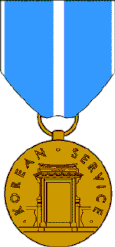TheKorean Service Medal(KSM) was amilitary award for service in the United States Armed Forcesand was established November 8, 1950, byexecutive orderofPresident Harry Truman.The Korean Service Medal is the primary US military award for service or participation in operations in theKorean areaduring theKorean Warbetween June 27, 1950, and July 27, 1954.[2][3]
| Korean Service Medal | |
|---|---|
 | |
| Type | Service medal |
| Awarded for | Service within territorial limits or service that directly supported the UN's military efforts in defense of South Korea between 1950 and 1954. |
| Description | Obverse:On a bronze medal, 1-1/4 inch in diameter, a Korean gateway, encircled by the inscription "KOREAN SERVICE". Reverse:On the reverse is the Korean "taegeuk" symbol taken from the center of the South Korean national flag with the inscription "UNITED STATES OF AMERICA" and a spray of oak and laurel encircling the design. Ribbon:The ribbon is 1-3/8 inches wide and consists of the following stripes: 1/32 inch White; 19/32 inch Bluebird; center 1/8 inch White; 19/32 inch Bluebird; and 1/32 inch White |
| Presented by | theUS Department of Defense |
| Eligibility | Military service during the Korean War |
| Campaign(s) | Korean War |
| Status | Inactive |
| Established | EO 10179,November 8, 1950, as amended[1] |
| First awarded | 1950 (retroactive to June 27, 1950) |
| Last awarded | July 27, 1954 |
Korean Service Medal ribbon & streamer | |
| Precedence | |
| Next (higher) | National Defense Service Medal |
| Next (lower) | Vietnam Service Medal |
| Related | Korean War Service Medal(Korea) Korean Defense Service Medal United Nations Korea Medal National Defense Service Medal Presidential Unit Citation(South Korea) |
Medal devices
editService stars
editTheUnited States Department of Defensedeclared thirteen official campaigns of the Korean War, all of which are annotated byservice starson the Korean Service Medal. Some campaigns apply to all branches of the US military, while others are branch specific. The Korean Service Medal is authorized a 3/16 "bronze or silver (indicates five campaigns) service star to denote participation in any of the following campaigns:
- North Korean Aggression (USMC, Navy): June 27 to November 2, 1950
- United Nations Defensive (Army, USAF): June 27 to September 15, 1950[4]
- Inchon Landing (USMC, Navy): September 13 to 17, 1950
- United Nations Offensive (Army, USAF): September 16 to November 2, 1950[4]
- Chinese Communist Forces Intervention (Army, USAF): November 3, 1950, to January 24, 1951[4]
- Communist China Aggression (USMC, Navy): November 3, 1950, to January 24, 1951
- First United Nations Counteroffensive (USMC, Army, Navy, USAF): January 25 to April 21, 1951[4]
- Chinese Communist Forces Spring Offensive (USMC, Army, Navy, USAF): April 22 to July 8, 1951[4]
- United Nations Summer-Fall Offensive (USMC, Army, Navy, USAF): July 9 to November 27, 1951[4]
- Second Korean Winter (USMC, Army, Navy, USAF): November 28, 1951, to April 30, 1952[4]
- Korean Defense Summer-Fall, 1952 (USMC, Army, Navy, USAF): May 1 to November 30, 1952[4]
- Third Korean Winter (USMC, Army, Navy, USAF): December 1, 1952, to April 30, 1953[4]
- Korea, Summer 1953 (USMC, Army, Navy, USAF): May 1 to July 27, 1953[4]
Arrowhead device
editAnarrowhead deviceis authorized for US Army or Air Force personnel to denote participation in each of the following:[5]
- Amphibious landing atInchon
- Airborne attacks on Sukch'on-Such'on and Munsan-Ni
Fleet Marine Force combat operation insignia
edit- TheFleet Marine Force Combat Operation Insigniais authorized for US Navy personnel who served with the Marine Corps at any time during the Korean War.
History
editAlthough theKorean War Armisticeended combat operations in Korea on 27 July 1953, the Korean Service Medal was issued until June 1954 due to the tense nature of the occupation and garrison duty immediately after the armistice, as well as the high possibility of a renewed attack byNorth Korea.After 1954, the Korean Service Medal was no longer issued although theArmed Forces Expeditionary Medalwas authorized for Korean area service between October 1, 1966, to June 30, 1974. As of 2004, a new medal known as theKorea Defense Service Medalwas authorized for members of the armed forces who served in the defense of the Republic of Korea from July 28, 1954, to a date to be determined.
The KSM was designed by theArmy Heraldic Section.The color scheme of the ribbon is derived from theFlag of the United Nations,as it was under the auspices of theUnited Nations(United Nations Security Council Resolution 82) that the war was conducted. The medal itself features a "Korean gateway," most likely aniljumun,on the front, and ataegeukon the reverse.[6]
TheUnited Nations Service Medal for Koreawas usually issued alongside the Korean Service Medal. Beginning in 1999, theRepublic of Korea War Service Medalwas also awarded to United States service members who received the Korean Service Medal. TheRepublic of Korea Presidential Unit Citationis retroactively authorized to any United States Army veteran who served in Korea during the War.
References
edit- ^Amended byEO 10429,January 17, 1953, andEO 13286,February 28, 2003. Additional details and descriptions given at32 CFR 578.44.
- ^"Korean Service Medal".U.S. Navy Service and Campaign Medals.Naval History and Heritage Command.
- ^"Korean Service Medal".The Institute of Heraldry.Archivedfrom the original on 27 Jan 2024.Retrieved27 Jan2024.
- ^abcdefghij"Fact Sheet: Korean Service Medal".afpc.af.mil.Air Force Personnel Center. Archived fromthe originalon 11 October 2014.Retrieved2 June2014.
- ^"Rank ribbons"(PDF).studyguides.af.mil.
- ^Kerrigan, Evans E. (1964). "The Korean War 1950-1953".American War Medals and Decorations.New York: The Viking Press. p. 103.OCLC702555627.